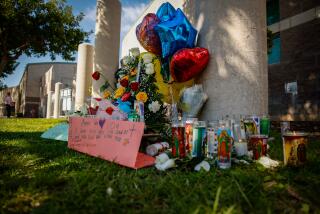Colorado slaying may be latest in serial shooter attacks, authorities fear
- Share via
The shooting death of a 65-year-old man in Loveland, Colo., is the latest in a number of attacks that has left law enforcement officials and suburban residents concerned that a serial shooter has set upon at least three towns in the northern part of the state.
William Roger Connole was shot and killed at 10:52 p.m. on Wednesday night, Police Chief Luke Hecker told reporters during a Thursday afternoon news conference.
Connole’s death came nearly three weeks after John Jacoby, 47, was shot and killed while riding his bike on a country road in nearby Windsor. One month before that, Cori Romero, 20, was shot in the neck while driving through Fort Collins. She survived the shooting.
The spate of seemingly random attacks have led a coalition of law enforcement agencies, including the FBI, to band together to try to capture the person or persons behind the shootings.
David Moore, public information officer for the Larimer County Sheriff’s Department, told reporters that while “there is no positive link” between Connole’s death and the attacks in Windsor and Fort Collins, investigators have “not been able to rule out a link either.”
Moore and Hecker would not say how many times Connole was shot, nor would they discuss any other evidence collected at the scene.
Last month, police said they had discovered evidence linking Jacoby’s slaying and the attack on Romero, but they have not said what specifically tied the two shootings together.
The attacks have already taken a toll on the residents of Fort Collins and Windsor, two cities where reports of gunfire can easily become front-page news. Windsor canceled a popular triathlon after Jacoby’s death, officials said, and residents of Fort Collins were left panicked by reports of car windows being shattered along Interstate 25 in late April.
“We believe we live in a very, very safe community,” Fort Collins City Councilman Gino Campana told the Los Angeles Times on Thursday. “Windsor was ranked one of the safest communities in the nation. This just doesn’t happen in our home.”
Jacoby, who was shot May 18 in Windsor, worked at a local grocery store and also served as a part-time caretaker with the local parks department, according to the FBI. A lifelong Windsor resident, he was friendly with several members of the police department’s 25-member force, said Lt. Rick Klimek.
Klimek would not comment on the weapon used in Jacoby’s death or say what police had discovered that linked the shooting to the attack on Romero in Fort Collins. He described the street where Jacoby was shot as a country road marked by the occasional farm. The two-lane road is mostly flanked by open space, he said.
Jacoby’s death marked the city’s first homicide in eight years, Klimek said, and the shooting has stoked concern, but not panic, among the town’s 21,000 residents.
“It’s a pretty resilient community. They’re all very concerned and upset that it took place, there’s been a much more hyper-vigilance,” Klimek told The Times. “But I haven’t seen anybody not engaging in normal activities.”
Tensions, however, appeared to be running high in Fort Collins the week after Romero was shot. On April 30, the Larimer County Sheriff’s office said it was increasing patrols along Interstate 25 after reports surfaced that several car windows had been shattered while drivers were on the highway.
Police said in a statement that there was no evidence to prove the windows were damaged by gunfire, or that they were linked to Romero’s shooting.
Campano said there were at least nine reports of shattered windows, which left motorists concerned they were being shot at while driving.
“It happens once, and it’s unfortunate. It happens twice? Same thing,” Campano said. “But now? Anything that has to do remotely with a shooting, and your mind goes to ‘Is this associated with what’s been taking place?’”
Follow @JamesQueallyLAT for breaking news
More to Read
Sign up for Essential California
The most important California stories and recommendations in your inbox every morning.
You may occasionally receive promotional content from the Los Angeles Times.











